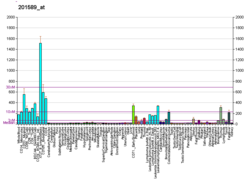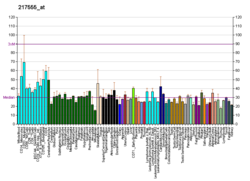SMC1A
SMC1A| SMC1A | |||||||||||||||||||||||||
|---|---|---|---|---|---|---|---|---|---|---|---|---|---|---|---|---|---|---|---|---|---|---|---|---|---|
| |||||||||||||||||||||||||
| 식별자 | |||||||||||||||||||||||||
| 별칭 | SMC1A, CDLS2, DXS423E, SB1.8, SMC1, SMC1L1, SMC1알파, SMCB, 염색체 1A, EIEE85, DE85의 구조적 유지관리 | ||||||||||||||||||||||||
| 외부 ID | OMIM: 300040 MGI: 1344345 HomoloGene: 4597 GeneCard: SMC1A | ||||||||||||||||||||||||
| |||||||||||||||||||||||||
| |||||||||||||||||||||||||
| |||||||||||||||||||||||||
| |||||||||||||||||||||||||
| 직교체 | |||||||||||||||||||||||||
| 종 | 인간 | 마우스 | |||||||||||||||||||||||
| 엔트레스 | |||||||||||||||||||||||||
| 앙상블 | |||||||||||||||||||||||||
| 유니프로트 | |||||||||||||||||||||||||
| RefSeq(mRNA) | |||||||||||||||||||||||||
| RefSeq(단백질) | |||||||||||||||||||||||||
| 위치(UCSC) | Cr X: 53.37 – 53.42Mb | Cr X: 150.8 – 150.85Mb | |||||||||||||||||||||||
| PubMed 검색 | [3] | [4] | |||||||||||||||||||||||
| 위키다타 | |||||||||||||||||||||||||
| |||||||||||||||||||||||||
염색체 단백질 1A(SMC1A)의 구조적 유지(Structural maintenance)는 인간에서 SMC1A 유전자에 의해 인코딩되는 단백질이다.[5][6]SMC1A는 자매 크로마티드 응집, 동질 재조합 및 DNA 루핑을 매개하는 응집체 복합체의 하위 단위다.체세포에서는 SMC1A, SMC3, RAD21, SA1 또는 SA2 중 하나로 응집력이 형성되는 반면 감수분열에서는 SMC3, SMC1B, REC8, SA3로 응집력이 형성된다.
SMC1A는 SMC 단백질 계열의 일원이다.이 가족의 구성원들은 DNA 수리, 염색체 응결, 그리고 박테리아에서 인간으로의 염색체 분리의 핵심 규제자들이다.[7]
구조
SMC 단백질의 도메인 조직은 보존성이 뛰어나며 N-단자 워커 A 모티브, 코일 코일, "힌지", 코일 코일 및 C-단자 워커 B 모티브로 구성되어 있다.단백질은 스스로 다시 접혀 한쪽 끝에는 이질화 "힌지" 영역, 다른 쪽 끝에는 ABC형 ATPase "head" 영역을 가진 로드 모양의 분자를 형성한다.이러한 구상 영역은 50nm의 반병렬 코일 코일로 구분된다.SMC3와 SMC1은 힌지 도메인을 통해 V자 모양의 헤테로디머를 생성한다.RAD21의 N단자 도메인은 헤드 도메인 바로 위에 SMC3의 코일형 코일에 바인딩되고 RAD21의 C단자 도메인은 SMC1의 헤드 도메인을 바인딩한다.SMC3-SMC1-RAD21 트리머의 이 엔드 투 엔드 바인딩은 DNA가 끼일 수 있는 폐쇄 링을 생성한다.
함수
세포 주기 동안 적절한 염색체 분리를 보장하기 위해 DNA를 결합하는 것 외에도, SMC1A는 결합의 구성 요소로서 원거리 요소 상호작용을 매개하는 염색체 간 접촉을 촉진하고 TAD(Topological Connecting Domain)라고 불리는 염색체 영역을 만드는 데 기여한다.응집력이 유전자 전사의 조절을 위한 촉진자와 촉진자 사이의 상호작용을 촉진하는 것이 제안되었다.[8][9][10][11][12][13]응집력의 제거는 여러 구획의 간격을 넓히는 루프가 서로 다른 구획의[14][15] loci 사이에서 혼합을 유도하기 때문에 비정상적인 TAD 위상을 유발한다. 그 결과 루프 손실은 유전자 발현 불규칙을 유발한다.[14]SMC1A는 스핀들 폴 형성에도 역할을 한다.실제로 SMC3와 연계하여 RAE1과의 상호작용을 통해 유사성 스핀들 폴에 채용하고 있다.SMC1A(하향 및 상향 조절 모두)의 조절 오류는 이상 다극성 스핀들을 유발하여 응집력이 스핀들 폴에 마이크로튜브를 고정하는 기능을 할 것임을 시사한다.[16][17]세포분열 시 염색체 분리의 올바른 분리를 위해서는 염색체 자매의 적절한 응집력이 필수적이다.자매 염색체 응집에는 응집성 다단백질 복합체가 필요하다.이 단지는 부분적으로 염색체(SMC) 단백질의 두 가지 구조 유지인 SMC3와 SMC1L2 또는 이 유전자에 의해 인코딩된 단백질로 구성되어 있다.대부분의 응집 복합체들은 비록 키네토코어의 그 복합체들은 남아있지만, 유사 이전의 염색체들과 분리된다.따라서 인코딩된 단백질은 기능성 키네토코르에서 중요한 부분으로 생각된다.또한, 이 단백질은 BRCA1과 상호작용하고 ATM에 의해 인산염화 되어 DNA 복구에서 이 단백질의 잠재적인 역할을 나타낸다.SMC 유전자 계열에 속하는 이 유전자는 X 불활성화를 탈출하는 X-크롬의 영역에 위치한다.[6]
임상적 유의성
코넬리아 데 란지 증후군
코넬리아 데 랑게 증후군(CdLS)은 이상형 특징, 심각한 성장지체, 전지구적 발달지체, 지적장애 등 임상적 이상이 가변적으로 나타나는 희귀 유전질환이다.빈도는 1:10,000명에서 1:30,000명까지 인종 간 차이가 없이 다양하다.[18]SMC1A는 CdLS에 관여해 온 다섯 가지 유전자 중 하나이다.SMC1A의 병원성 변종인 오식 및 프레임 삭제는 CdLS와 연관된다. 인코딩된 단백질의 프레임을 유지하는 SMC1A 변종은 중간 정도의 신경인지장애를 가진 온건한 CdLS 표현형과 주요 구조적 결함의 빈도와 관련이 있다.SMC1A에 영향을 받은 남성의 표현형은 돌연변이 여성의 표현형보다 더 심각하다.[19][20][21]SMC1A가 X 불활성화를 면한 이후, 영향을 받는 여성의 메커니즘이 돌연변이 단백질의 지배적 음성 효과라는 가설이 제기되었다.
게놈 불안정 및 암
SMC1A도 DNA 복구에 참여한다.SMC1A의 하향규제로 인해 게놈 불안정성이 발생하며 SMC1A 변종이 있는 CdLS 세포는 높은 수준의 염색체 이상을 보인다.[22][23][24]또한 SMC1A는 화학 처리 또는 이온화 방사선에 의해 유발된 DNA 손상에 따라 ATM과 ATR Threonine/serine 키나제에 의해 Ser957 및 Ser966 잔류물에 인산염화된다.그것은 phosphorylating SMC1A에서S-phase 검문소 세포 주기의 차단과 DNA.[25][26][23]SMC1A 변형들의 수리 피, 뇌, 방광, 대장 암에서 식별된 허용하는 활성화에 필요한 것은 유방 암 유형 1감수성(1기 유방 암)유전자 collaborates,을 가정해 왔다.[27][28][29][30][31일][32][33]SMC1A는 대장종양에 중추적인 역할을 한다.실제로 대장조직은 암 발생 시 SMC1A의 여분의 복사를 획득하며 발현이 일반 점막이나 초기 선종보다 암에서 현저하게 강하다.[33]마지막으로 SMC1A의 상향 조정은 대장암에서의 좋지 않은 예후를 예측하는 것으로 생각된다.[34]
메모들
이 글의 2020년 버전은 이중 출판 모델에 따라 외부 전문가에 의해 갱신되었다.해당 학술적 동료 검토 기사는 진에 게재되었으며, 다음과 같이 인용할 수 있다. Antonio Musio (25 March 2020). "The multiple facets of the SMC1A gene". Gene. Gene Wiki Review Series. 743: 144612. doi:10.1016/J.GENE.2020.144612. ISSN 0378-1119. PMC 8011328. PMID 32222533. Wikidata Q90721076. |
참조
- ^ a b c GRCh38: 앙상블 릴리스 89: ENSG000072501 - 앙상블, 2017년 5월
- ^ a b c GRCm38: 앙상블 릴리스 89: ENSMUSG000041133 - 앙상블, 2017년 5월
- ^ "Human PubMed Reference:". National Center for Biotechnology Information, U.S. National Library of Medicine.
- ^ "Mouse PubMed Reference:". National Center for Biotechnology Information, U.S. National Library of Medicine.
- ^ Rocques PJ, Clark J, Ball S, Crew J, Gill S, Christodoulou Z, et al. (February 1995). "The human SB1.8 gene (DXS423E) encodes a putative chromosome segregation protein conserved in lower eukaryotes and prokaryotes". Human Molecular Genetics. 4 (2): 243–9. doi:10.1093/hmg/4.2.243. PMID 7757074.
- ^ a b "Entrez Gene: SMC1A structural maintenance of chromosomes 1A".
- ^ Yatskevich S, Rhodes J, Nasmyth K (December 2019). "Organization of Chromosomal DNA by SMC Complexes". Annual Review of Genetics. 53: 445–482. doi:10.1146/annurev-genet-112618-043633. PMID 31577909.
- ^ Wendt KS, Yoshida K, Itoh T, Bando M, Koch B, Schirghuber E, et al. (February 2008). "Cohesin mediates transcriptional insulation by CCCTC-binding factor". Nature. 451 (7180): 796–801. Bibcode:2008Natur.451..796W. doi:10.1038/nature06634. PMID 18235444. S2CID 205212289.
- ^ Hadjur S, Williams LM, Ryan NK, Cobb BS, Sexton T, Fraser P, et al. (July 2009). "Cohesins form chromosomal cis-interactions at the developmentally regulated IFNG locus". Nature. 460 (7253): 410–3. Bibcode:2009Natur.460..410H. doi:10.1038/nature08079. PMC 2869028. PMID 19458616.
- ^ Dixon JR, Selvaraj S, Yue F, Kim A, Li Y, Shen Y, et al. (April 2012). "Topological domains in mammalian genomes identified by analysis of chromatin interactions". Nature. 485 (7398): 376–80. Bibcode:2012Natur.485..376D. doi:10.1038/nature11082. PMC 3356448. PMID 22495300.
- ^ Nora EP, Lajoie BR, Schulz EG, Giorgetti L, Okamoto I, Servant N, et al. (April 2012). "Spatial partitioning of the regulatory landscape of the X-inactivation centre". Nature. 485 (7398): 381–5. Bibcode:2012Natur.485..381N. doi:10.1038/nature11049. PMC 3555144. PMID 22495304.
- ^ Seitan VC, Faure AJ, Zhan Y, McCord RP, Lajoie BR, Ing-Simmons E, et al. (December 2013). "Cohesin-based chromatin interactions enable regulated gene expression within preexisting architectural compartments". Genome Research. 23 (12): 2066–77. doi:10.1101/gr.161620.113. PMC 3847776. PMID 24002784.
- ^ Sofueva S, Yaffe E, Chan WC, Georgopoulou D, Vietri Rudan M, Mira-Bontenbal H, et al. (December 2013). "Cohesin-mediated interactions organize chromosomal domain architecture". The EMBO Journal. 32 (24): 3119–29. doi:10.1038/emboj.2013.237. PMC 4489921. PMID 24185899.
- ^ a b Rao SS, Huang SC, Glenn St Hilaire B, Engreitz JM, Perez EM, Kieffer-Kwon KR, et al. (October 2017). "Cohesin Loss Eliminates All Loop Domains". Cell. 171 (2): 305–320.e24. doi:10.1016/j.cell.2017.09.026. PMC 5846482. PMID 28985562.
- ^ Schwarzer W, Abdennur N, Goloborodko A, Pekowska A, Fudenberg G, Loe-Mie Y, et al. (November 2017). "Two independent modes of chromatin organization revealed by cohesin removal". Nature. 551 (7678): 51–56. Bibcode:2017Natur.551...51S. doi:10.1038/nature24281. PMC 5687303. PMID 29094699.
- ^ Wong RW (January 2010). "Interaction between Rae1 and cohesin subunit SMC1 is required for proper spindle formation". Cell Cycle. 9 (1): 198–200. doi:10.4161/cc.9.1.10431. PMID 20016259.
- ^ Wong RW (May 2010). "An update on cohesin function as a 'molecular glue' on chromosomes and spindles". Cell Cycle. 9 (9): 1754–8. doi:10.4161/cc.9.9.11806. PMID 20436296.
- ^ Ramos FJ, Puisac B, Baquero-Montoya C, Gil-Rodríguez MC, Bueno I, Deardorff MA, et al. (October 2015). "Clinical utility gene card for: Cornelia de Lange syndrome". European Journal of Human Genetics. 23 (10): 1431. doi:10.1038/ejhg.2014.270. PMC 4592075. PMID 25537356.
- ^ Musio A, Selicorni A, Focarelli ML, Gervasini C, Milani D, Russo S, et al. (May 2006). "X-linked Cornelia de Lange syndrome owing to SMC1L1 mutations". Nature Genetics. 38 (5): 528–30. doi:10.1038/ng1779. PMID 16604071. S2CID 12277809.
- ^ Borck G, Zarhrate M, Bonnefont JP, Munnich A, Cormier-Daire V, Colleaux L (February 2007). "Incidence and clinical features of X-linked Cornelia de Lange syndrome due to SMC1L1 mutations". Human Mutation. 28 (2): 205–6. doi:10.1002/humu.9478. PMID 17221863.
- ^ Deardorff MA, Kaur M, Yaeger D, Rampuria A, Korolev S, Pie J, et al. (March 2007). "Mutations in cohesin complex members SMC3 and SMC1A cause a mild variant of cornelia de Lange syndrome with predominant mental retardation". American Journal of Human Genetics. 80 (3): 485–94. doi:10.1086/511888. PMC 1821101. PMID 17273969.
- ^ Musio A, Montagna C, Zambroni D, Indino E, Barbieri O, Citti L, et al. (June 2003). "Inhibition of BUB1 results in genomic instability and anchorage-independent growth of normal human fibroblasts". Cancer Research. 63 (11): 2855–63. PMID 12782591.
- ^ a b Musio A, Montagna C, Mariani T, Tilenni M, Focarelli ML, Brait L, et al. (February 2005). "SMC1 involvement in fragile site expression". Human Molecular Genetics. 14 (4): 525–33. doi:10.1093/hmg/ddi049. PMID 15640246.
- ^ Cukrov D, Newman TA, Leask M, Leeke B, Sarogni P, Patimo A, et al. (September 2018). "Antioxidant treatment ameliorates phenotypic features of SMC1A-mutated Cornelia de Lange syndrome in vitro and in vivo". Human Molecular Genetics. 27 (17): 3002–3011. doi:10.1093/hmg/ddy203. PMID 29860495.
- ^ Kim ST, Xu B, Kastan MB (March 2002). "Involvement of the cohesin protein, Smc1, in Atm-dependent and independent responses to DNA damage". Genes & Development. 16 (5): 560–70. doi:10.1101/gad.970602. PMC 155347. PMID 11877376.
- ^ Yazdi PT, Wang Y, Zhao S, Patel N, Lee EY, Qin J (March 2002). "SMC1 is a downstream effector in the ATM/NBS1 branch of the human S-phase checkpoint". Genes & Development. 16 (5): 571–82. doi:10.1101/gad.970702. PMC 155356. PMID 11877377.
- ^ Balbás-Martínez C, Sagrera A, Carrillo-de-Santa-Pau E, Earl J, Márquez M, Vazquez M, et al. (December 2013). "Recurrent inactivation of STAG2 in bladder cancer is not associated with aneuploidy". Nature Genetics. 45 (12): 1464–9. doi:10.1038/ng.2799. PMC 3840052. PMID 24121791.
- ^ Ley TJ, Miller C, Ding L, Raphael BJ, Mungall AJ, Robertson A, et al. (May 2013). "Genomic and epigenomic landscapes of adult de novo acute myeloid leukemia". The New England Journal of Medicine. 368 (22): 2059–74. doi:10.1056/NEJMoa1301689. PMC 3767041. PMID 23634996.
- ^ Cucco F, Servadio A, Gatti V, Bianchi P, Mannini L, Prodosmo A, et al. (December 2014). "Mutant cohesin drives chromosomal instability in early colorectal adenomas". Human Molecular Genetics. 23 (25): 6773–8. doi:10.1093/hmg/ddu394. PMID 25080505.
- ^ Huether R, Dong L, Chen X, Wu G, Parker M, Wei L, et al. (April 2014). "The landscape of somatic mutations in epigenetic regulators across 1,000 paediatric cancer genomes". Nature Communications. 5: 3630. Bibcode:2014NatCo...5.3630H. doi:10.1038/ncomms4630. PMC 4119022. PMID 24710217.
- ^ Thol F, Bollin R, Gehlhaar M, Walter C, Dugas M, Suchanek KJ, et al. (February 2014). "Mutations in the cohesin complex in acute myeloid leukemia: clinical and prognostic implications". Blood. 123 (6): 914–20. doi:10.1182/blood-2013-07-518746. PMID 24335498.
- ^ Cessna MH, Paulraj P, Hilton B, Sadre-Bazzaz K, Szankasi P, Cluff A, et al. (October 2019). "Chronic myelomonocytic leukemia with ETV6-ABL1 rearrangement and SMC1A mutation". Cancer Genetics. 238: 31–36. doi:10.1016/j.cancergen.2019.07.004. PMID 31425923.
- ^ a b Sarogni P, Palumbo O, Servadio A, Astigiano S, D'Alessio B, Gatti V, et al. (March 2019). "Overexpression of the cohesin-core subunit SMC1A contributes to colorectal cancer development". Journal of Experimental & Clinical Cancer Research. 38 (1): 108. doi:10.1186/s13046-019-1116-0. PMC 6397456. PMID 30823889.
- ^ Wang J, Yu S, Cui L, Wang W, Li J, Wang K, Lao X (March 2015). "Role of SMC1A overexpression as a predictor of poor prognosis in late stage colorectal cancer". BMC Cancer. 15: 90. doi:10.1186/s12885-015-1085-4. PMC 4352287. PMID 25884313.










